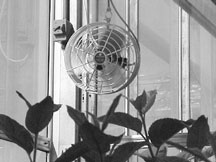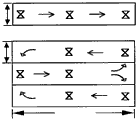
Horizontal air flow fan used to circulate air in a greenhouse.
Jessica J. Prenger
Research Engineer
Peter P.
Ling
Assistant Professor
The microclimate around plants can have a significant effect on their health and development. Air circulation is one method to reduce climate differences and maintain a uniform temperature and humidity throughout a greenhouse. High humidity and condensation on plants lead to disease and other humidity related problems. Condensation problems occur when moisture in warm air condenses on cool leaf and covering surfaces. One of the causes of the problem is that typical measurements of greenhouse air temperature and humidity are taken several feet away from plants. Although the measurements may be acceptable, a very different environment might develop near the plants.
Air movement can be improved using several techniques. If benches are used in the production system, the air circulation will benefit from open mesh or slatted benches. In all operations, the plants should be given adequate space. These measures significantly improve movement of air in and around the plant canopy. The most aggressive method is to produce air movement using horizontal air flow (HAF) fans or perforated poly tube systems. These are operated to mix the air, reducing temperature and humidity gradients. The following discussion lists some important guidelines for selecting and installing HAF fans and perforated poly tube systems.

The HAF equipment provides additional mixing for a uniform climate in the greenhouse aside from exhaust fans and vent openings. Both HAF fans and perforated poly tubes can do a good job of circulating air, though they must be sized appropriately. Perforated poly tubes are most often used as heat distributors, but can be used for circulation if they are large enough. However, reduced fan pressures, lower maintenance, and initial costs make HAF fan circulation more efficient than perforated poly tubes. Another important consideration for HAF fans is to "shroud" the fan, that is, to direct the flow forward with a housing around the fan. The housing can increase air delivery with no additional power input. Table 1 lists the criteria for designing these systems.
Air circulation equipment should be used when greenhouse air is otherwise stagnant, or gradients in temperature or humidity are evident. During the winter, it is common for vents to be closed, and the heating system can create pockets of warm air. Circulation is needed to mix the air, and prevent condensation-friendly microclimates near the plant canopy. Some experts suggest running the circulation fans continuously during the heating season (ASAE EP406.2). During the cooling season, run the circulation fans whenever the exhaust fans are not running. However, there are situations when circulation is not appropriate. For example, in a ridge vented greenhouse, it may be necessary to enhance vertical airflow by turning off the HAF equipment. To save energy, turn off fans during periods of forced ventilation since the air movement may already be sufficient; however, very long greenhouses (over 150 feet) may require additional circulation to move ventilation air (NRAES-33).
Fans and poly tubes should receive regular maintenance to achieve the desired results and avoid problems. Poly tubes should be replaced each year to minimize dust build-up. Torn or deteriorated tubes should be replaced (Kelly, 1994). HAF fans should be maintained according to manufacturer suggestions.
| Table 1. Criteria for Designing Air Circulation Systems | ||
|---|---|---|
| Specification | Horizontal Air Flow Fans | Perforated Poly Tube System |
| Size | Total fan capacity: 2 cubic feet per minute (CFM) for every square foot of ground area; air flow velocity in the vicinity of the canopy should not exceed 200 ft/min. | Total fan capacity: 2 CFM / 1 ft2 ground area; holes every 1'-3', arranged so that air does not blow directly on plants. |
| Orientation/ Height | Aim 10¢X-15¢X toward center; fans should be 2-3 feet above the height of the crop. | Tubes should be no higher than 8' above the floor. |
| Layout requirements |  1. Add a row of fans for each additional 40'
width. 1. Add a row of fans for each additional 40'
width.2. For odd numbers of bays (3 or more), the center bays should flow in the same direction. 3. The inlet side of the first fan should be about 8 fan diameters from the end of the greenhouse wall; ex. a 3 ft. diameter fan should be approximately 24 feet from the end wall. 4. The fans should be spaced no farther apart than 30 times the diameter of the fan blade; ex. a 3 ft. diameter fan should be no more than 90 feet apart. The last fan (in the direction of air flow) should be no more than 90 feet from the end wall. |
1. Add a poly tube for every 30' of additional width. 2. The maximum effective length is 100'-120'.  |
Air circulation is an important part of climate control for disease management. Open mesh benches and well-spaced plants can improve the circulation around and through the canopy. The circulation system must be designed to provide adequate mixing of the air, and reach all areas of the greenhouse.
Aldrich, R.A. and J.W. Bartok, Jr. 1989. Greenhouse Engineering. NRAES-33. Northeast Regional Agricultural Engineering Service. Cornell University, Ithaca, NY.
ASAE Fundamentals. EP406.2 "Heating, Ventilating, and Cooling Greenhouses." American Society of Agricultural Engineering, St. Joseph, MI.
Bakker, J.C. et al. (Eds.) Greenhouse Climate Control-An integrated approach. Wageningen, The Netherlands: Wageningen Pers. 1995.
Cuny, H. "Engineer the environment. How environmental control helps plants and hinders pathogens." Greenhouse Management and Production. February 1995: 30-32, 36-37.
Kelly, M.K. "The Well-Ventilated Greenhouse." GrowerTalks. April 1994: 54-57.